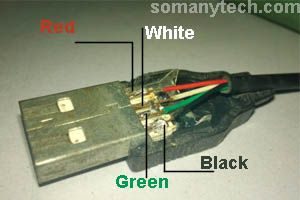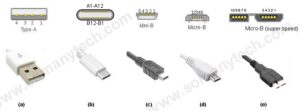How to Wire a Usb Cable for Power
If you are searching for the USB wiring diagram, you are at the right place. The wiring diagram includes any combination of different types of USB connectors. The most common is "USB micro-B" to standard "USB-A" which is generally represent in mobile chargers.
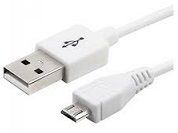
USB wiring diagram comes in handy when USB port or connector either of them malfunctions or completely out of order, also for engineers and hobbyist who wants to explore the electronics practically.
This malfunctioning occurs due to excessive use of USB wire (here excessive use means repetitive use of wire or connecting port in a short duration of time). Improper use like rugged applications, inappropriate insertion into port, i.e without checking port orientation.
Another Practice is bending the wire greater than 90 degrees, which causes the copper wires in the bundle to get damaged due to its slightly brittle property. Copper is having one of the best malleability and ductility properties. And therefore copper is widely used as a conductor in a wire even having this property, the copper wire undergoes degradation.
Before wiring USB you need to know the pinout diagram of USB. Below is the figure showing the pinout diagram of the USB micro-B and USB-A wiring diagram.
Type-A USB pinout diagram, micro USB pinout diagram along with USB wiring diagram:
This cable is most commonly used in mobile charger for charging mobile phones and as a USB data cable to connect mobile devices to tranfer files and images between personal computers and phones.
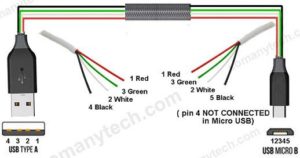
Description: USB wiring is simple but not that simple this is because on changing the frame of reference the pinout looks changed. Observe the above pinout the front end is different than that of back end and thus it requires to check the connectivity of both ends with a digital multimeter (above micro USB pinout made it simple for you).
Table of male USB-A pinout & USB-B pinout:
Pin no. | Name | Wire code | Description | |
|---|---|---|---|---|
| 1 | VCC | Red/ Orange | +5V (dc power) | |
| 2 | D- | White/ Gold | Data- (data from device to host) | |
| 3 | D+ | Green | Data+ (data from host to device) | |
| 4 | GND | Black/ Blur | 0V (dc ground) |
The table showing pin number and their nomenclature along with its function in short.
- Pin no.1 showing the power supply (+VDD) through that pin the power is supplied to the device or any equipment which is also an indicator of handshake signal, means "the device is connected".
- According to the USB standard power supply is +5V.(but note that the capacity of the power supply is different for different USB versions)
- Whereas, "pin no. 2" (-D) is used as a differential data pin, similarly "pin no. 3" (+D) is also used as a differential data pin.
- The work of the differential data pin is to send and receive the data in a particular format called USB protocol.
- Pin no. 4 is used as ground. The color code for the wire used in the USB cable red, white, green, grey, black for pin numbers 1, 2, 3, 4 and 5.
- Please take note of type-A & type-B have the same pinout diagram after arranging on the basis of similarity of shape.
USB pinout and its connector:
There are the female connectors for each of the male connectors in practical having the same pinout as that of the male connector. The most common types of connectors are displayed in this image.
Table of mini and micro USB pinout type-b & type-a:
| Pin no. (look pinout figure) | Name | Wire code | Description |
|---|---|---|---|
| 1 | VCC | Red | +5V (dc power bus) |
| 2 | D- | White | Data- (device to host) |
| 3 | D+ | Green | Data+ (host to device) |
| 4 | ID | N/A (dark blue / black)* | OTG-ID (generally not connected, if so then grounded/ according to the device need) |
| 5 | GND | Black | 0V (dc ground) |
- The pinout diagram for the micro USB type-B very similar to USB type-A except for the last two pins 4 and 5. Also, it is the same for micro USB type-a and micro USB type-b.
- The pin no.1 is +5V acts as a source to the device or source from the device.
- Pin no.2 and pin no.3 are data lines (also called differential data lines because its application varies with the requirements).
- The pin no. 4 (ID)is used for device identification especially in modern devices for OTG connections eg. smartphone OTG connector to connect a USB drive directly to the mobile phone.
- And the last pin no. 5 is a connection for ground signal which is pin no. 4 type USB-A through a wire.
How to find the USB wiring diagram easily?
Step1: First of all find out the type of USB connector used in the cable.
Step2: After the identification of the type of USB connector used on both ends, note down the pinout diagram of that particular USB type.
Step3: Note down all the color of the cable and where it is connected to the actual USB connector on a page. (rough sketch diagram will work)
Step4: Now connect connector pin and wires from the bunch acquire according to the color code and pinout of that particular USB connector on the page using a pen, and your USB wiring diagram is ready.
List of standard USB connectors available commercially in the market which you can buy:
1) USB A male to USB B male.
2) USB A male to USB B female.
3) USB A male to mini USB B male.
4) USB A male to micro USB B male.
5) USB A male to USB C male.
Micro USB pinout insight and USB-C:
- The micro USB connector is most commonly used for charging mobile phones and various other portable devices like Bluetooth headset, Bluetooth speaker, Mini drones, Power Banks.
- Some of the device manufacturers use their own standard of not connecting the data pin, as the cable is only made to work for charging purposes where only power bus/ wire is required to reduce the manufacturing cost.
You must have had thought of the question, why most of the devices use micro USB?
Most of the devices use micro USB due to the fact that it is compact than all of its precedents in shape and size. And after that, no other type of USB is able to replace it except USB-C ©.
USB-C is more complex micro USB-a than micro USB-b. The micro USB-C is simply called as USB-C.
The image and pinout of USB C are as follows:
| Pin | Name | Pin | Name | Description |
|---|---|---|---|---|
| A1 | GND | B12 | GND | DC ground (+0V) |
| A2 | TX1+ | B11 | TX2+ | Super speed data transmit+ (host to device) |
| A3 | TX1- | B10 | TX2- | Super speed data transmit- (device to host) |
| A4 | VDD | B9 | VDD | DC power (+5V) |
| A5 | CC1 | B8 | CC2 | Power delivery communication line |
| A6 | D+ | B7 | D+ | speed data transmit- (host to device) |
| A7 | D- | B6 | D- | speed data transmit- (device to host) |
| A8 | SBU1 | B5 | SBU2 | secondary bus |
| A9 | VDD | B4 | VDD | DC power (+5V) |
| A10 | RX2- | B3 | RX1- | Super speed data receive- (device to host) |
| A11 | RX2+ | B2 | RX1+ | Super speed data receive+ (host to device) |
| A12 | GND | B1 | GND | DC ground (+0V) |
You can see a noticeable difference between USB C and micro USB. As you can observe that USB C can be inserted from any of the orientation. On the contrary, micro USB is direction oriented and we have to give attention while inserting it into the device.
USB C has the advantage of orientation, on the other hand, it has the disadvantage of ring complex on the design level for the programmer and engineers.
Apart from this, micro USB comes in three variants (they have principally same micro USB pinout) as shown in the figure.
The image and pinout of USB b super speed are as follows:
| Pin no. | Name | Wire code | Description |
|---|---|---|---|
| 1 | VDD | Red | +5V (dc power source) |
| 2 | D- | White | D- (differential data pin) data negative |
| 3 | D+ | Green | D+ (differential data pin) data positive |
| 4 | ID | N/C (dark blue / black) | OTG identification pin (generally not connected/ grounded) |
| 5 | GND | Black | 0V (signal ground) |
| 6 | SSTx- | Blue | Superspeed transmit- |
| 7 | SSTx+ | Yellow | Superspeed transmit+ |
| 8 | GND | N/C (custom color pattern/ dark blue/ black) | Grounding |
| 9 | SSRx- | Purple | Superspeed receive- |
| 10 | SSRx+ | Orange | Superspeed receive+ |
The USB b superspeed pinout is the combination of USB b and 5 auxiliary pins which are predominantly used in high-speed External Hard Drives. The description section of the table above is self-explanatory.
These variants alond with USB wiring diagram are decided by the usb.org, which is a 'USB standards organization' that maintains USB standards and improvise the USB technology and its applications.
i) micro a( USB 1.1 to 2): Previously in mobiles, now discontinued.
ii) micro b( USB 1.1 to 2): All current mobiles/ laptops/ desktop PC.
iii) micro b( USB 3.0): External hard drive/latest smartphone/ laptops.
Important things to consider about USB wiring diagram of cables:
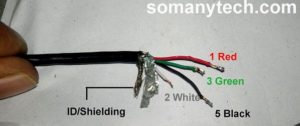
- Check that if you are USB cord has more than 4 wires then 5th one must be a bare/ open conductor. This open wire is generally surrounded to the four main wire from around. This arrangement is called as shielding.
- To prevent external noise shielding is necessary. The most common practice is to ground shielding with the host and external device.
- Shielding is generally avoided in low quality cheaply made USB cables, which is not in the favor of good quality USB cords. It is very important for the protection of data. Also for avoiding loss of data and hardware faults.
USB color code:
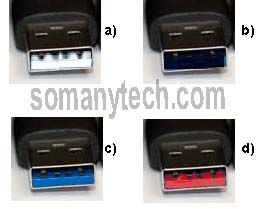
Very few people know that the USB connector has a color code. This color code is given to the USB on the basis of its standards defined by its organization. The colors are white, black, blue, red/ yellow.
a) White: It was introduced in 1996 (now outdated).It has a very low speed. The version it came from is USB 1.XX.
b) Black: It was in the market since the year 2000. It's under version USB 2.XX. Its speed is up to 480 Mbps.
c) Blue: It published under the version USB 3.XX in 2008. Its maximum speed is 5 Gbps.
d) Red/Yellow: It is very same as USB3.XX with an upgraded feature of "sleep and charge". This means that your device with this feature will not stop power supply even if the host device is turned off. This is very helpful for charging the mobile phone according to our convenience.
How to Wire a Usb Cable for Power
Source: https://somanytech.com/usb-wiring-diagram-micro-usb-pinout-guide/

